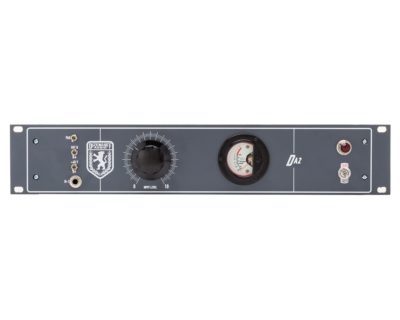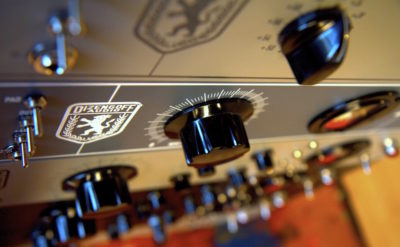New Gear Review: DA2 Tube Preamp from Dizengoff Audio
Chicago’s Dizengoff Audio, manufacturers of boutique-style vintage-inspired gear, have just released their newest product, a mic pre with a lot of vibe, a very low noise floor, and an extremely (almost unbelievably) affordable price.
The Dizengoff Audio DA2 is based on the legendary all-tube RCA BA-2c microphone preamplifier from the 1950s, and shares some of it’s predecessor’s features while offering some design tweaks with a “Chicago twist”, including some modern features not found on the old stuff: XLR ins and outs, front panel 1/4” unbalanced DI input, 20dB pad, phase flip and phantom power controls.
Perhaps best of all, it’s powered with a standard IEC cord, so unlike the original units (or pretty much any other vintage tube mic pre for that matter) there is no impossible-to-find power supplies, custom racking or hot rodding necessary with this unit
In Use
We have heard those ancient vibey tones of the 1950s RCA preamps on so many old recordings, broadcasts, narrations. They’re often edgy, a little bit spooky, open and “tubey”. And that’s precisely how one could describe the sound of the DA2. It certainly has a tone of it’s own while—not sounding wildly over-colored either—and it certainly competes well with other preamps costing much, much more.
Whenever trying reissue gear, I always like to have an original vintage example in good shape to compare to the re-issue device in question Unfortunately, there weren’t any RCA BA-2cs around for this review, but I did have two other worthy preamps for comparison: A vintage Neve 1080 (the same mic pre circuit as the 1073, probably the most highly-regarded mic preamp in the music world of the past 40+ years), and a 1959 Ampex 601 all-tube mic preamp, so that we’d have something from a similar era and design to the RCA pre that the DA2 is based off of.
I used a Neumann U67 on two different male vocals, as well as two old RCA classics: The 44bx and 77dx for some period-correct (and manufacturer-matching) ribbon mic variety.
The differences in tonal qualities between the three preamps compared were significant. On vocals, the Neve was extremely rich, had a heavy and girthy low-end, and some good transistor focus and punch. (It also came with a price tag multiple times higher than either of the other units tested).
While not exactly thin-sounding, the Ampex preamp certainly had a much thinner sound in the lows than the Neve did, although much glassier in the highs, and also had some noticeable harmonics, making it a totally different vibe from the Neve entirely. Then I tried the new Dizengoff DA2.
The first thing one notices when using the DA2 is the ancient-looking 1950s-style VU meter and the single large knob for gain. There is no second gain stage to adjust, no trim, no crazy new feature ideas—just one big knob, just as the original BA-2c had.
If you want distortion, you have to drive the input with a nice healthy source. For the most part though, you won’t really hear distortion, though at higher gain settings, the DA2 imparts a beautiful warm fuzziness that you don’t get out of just any tube gear. It sounds VERY musical.
Tonally, the DA2 was much closer to the Ampex pre than it was to the Neve.
Compared to the Neve, I did not find the DA2 to have the “low mid wallop” that the manufacturer describes. (Although in fairness, Neve pres are pretty much heavier in the low mids than everything else on the planet).
Compared to the Ampex however, the Dizengoff was a little weightier, and had both a quieter and cleaner sound than either of the other pres I tested it against.
While it looks sort of “old” and certainly has that old sound—most notably, the tone of the mids have a certain “lift” or “edge” reminiscent of that classic old broadcast sound—there’s also something very “new” and “clean” about this thing and how it actually operates.
Those are some of the plusses. The sound is definitely good—and vibey—and that’s probably what’s most important.
The price is another major plus. At only $669, this has got to be one of the cheapest, if not the cheapest of the high-quality vintage gear reissues that isn’t made for a 500-series rack.
It’s truly great to see that someone is making some boutique-style retro recreation gear for such an affordable price. I did not actually look at the price until after I had done a bunch of testing, and then after doing that testing, I figured that based on the sound quality and the looks of it under the hood, this must sell for at least $1000, maybe $1500 or even $2000.
In the end, the price and tone are really the best things about this unit, and those are two factors people tend to care about most.
I’m not sure if all models come like this, but the model I demoed came with a pair of “New Old Stock” American-made GE 6CB6A tubes. While not really worth tons of money, finding NOS tubes in any gear manufactured today is an impressive feature, and for something that only costs $669, it seems hard to believe Dizengoff could pull this off. My guess is that quantities must be limited, and that Dizengoff will not be manufacturing these things forever.
To Be Critical
For all the pluses, there are some minuses as well, as there almost always are. The first of these is that the unit only achieves 52db of gain when all the way up.
I should note that the original RCA BA-2c was the same way, so this isn’t a design “flaw” on Dizengoff’s part. If anything, this quality shows their commitment to the original design.
For the most part, for most people, most of the time, only having 52db of mic gain isn’t a huge deal. If you have a mic that doesn’t have a very high output and you want to record an acoustic guitar, you might not be able to record at a level quite as loud as what you might normally track at, but, it probably won’t really matter in this 32 bit digital age.
Where it does matter is when you have a source like an old ribbon mic or a passive Fender Rhodes output to deal with. I managed to make recordings that were passable using RCA ribbon mics on a voiceover and a Rhodes going into the front panel DI, but that Input Level pot was cranked all the way to 10, and I tended to be peaking at only -25dbFS on the way into my A/D converter.
Some good old “Clip Gain” can certainly fix this, and so can adding a compressor with extra gain makeup after the preamp, but either way, this unit may lack enough gain for certain low-level sources.
Because of this, I would beware of this preamp if you planned on using with old ribbon mics. Though you might think it would be ideal for old ribbons, since RCA dominated the American mic manufacturing scene with their ribbon mics at the time of the BA-2c in the 1950s, I think it’s safe to say that Dizengoff wasn’t focusing on matching this preamp with old, low output RCA ribbon mics. They are, after all, using new, Chicago-made Peerless transformers on the inputs and outputs, and it’s quite possible they are not intended to spec the same way the transformers in the old BA-2c’s would have been. (Either that or engineers of yesteryear had it even worse off than we might have realized.)
On any modern condenser or dynamic mic with a decent output however—which is what most people are using nowadays for most everything on most kinds of music—the DA2 should provide enough gain to satisfy your needs 98% of the time. I’d imagine it would even pair well with many higher-output modern ribbons, particularly of the active variety.
Another quibble that may come up is that while the manufacturer boasts that the units are hand-made, they are not by any means point-to-point, hand-wired. Under the hood, it’s all PC boards and ribbon cables.
Is this actually a “minus” though? Very debatable. Some might argue that PCB circuitry degrades sound quality in comparison to the old point-to-point style of wiring, some might say it doesn’t matter at all—or could even be better—but what’s for sure is that using PCB’s makes the DA2 cheaper to manufacture, and I imagine that if this unit was wired identically to the BA-2c, by hand, it would be a whole lot costlier than $669.
The final minus, and it isn’t a huge one either — I wasn’t blown away by the DI’s sound. It wasn’t bad by any means, and these front panel DI’s can be set up all kinds of ways and work very differently on different sources. It might sound great with an active bass guitar but mediocre with a passive one, or vice versa, for example.
I tried this DI input with both a modern synth that featured an active output (a Korg microKORG) and with a passive Fender Rhodes. I also tried the DA2 using a passive Radial JDI direct box instead of the DA2’s built-in DI. The passive JDI seemed to add a little extra “size” and “iron” to the sound, even just slightly, while the DA2’s built-in DI seemed a little “cleaner” and “simpler” sounding. I wouldn’t necessarily avoid the front panel DI, it just didn’t make me jump out of my seat when I first heard it.
The Rhodes recorded very quietly as mentioned previously, but the DA2 had no issues with direct recording of the microKORG. I was able to get a nice hot signal without cranking the DA2’s input level knob all the way up. For a less fuzzy sound, record quieter. For a slightly fuzzier sound (but never too fuzzy) record louder. The VU meter was a help. When the needle hits the red, the sound gets a little more interesting.
Summing it Up
In conclusion, I’d say that if you want a tube mic pre for some vintage 1950s/60s tones and some cool vibes, this is absolutely one to consider. A real RCA BA-2c or OP6 might nail the tone a little bit more, but good luck finding one, good luck getting it working to spec, and good luck making that happen for $669!
If you just want a decent mic pre for under $1000 that’s clean but with character, this is absolutely a mic pre to consider. If you want a tube mic pre that can do lots of distortion and sound real gritty, this probably wouldn’t be the first choice, as it can’t get too wild with the harmonics. (Although, adding your own output attenuator before your A/D input might be a solution).
The harmonics the DA2 does possess however, are very unique and very musical, yet also tastefully subtle. It’s a certain sweet “fuzziness” that until now, you’d never hear coming out of a home studio—or most commercial studios in 2016 for that matter.
At $669, the Dizengoff DA2 is an amazing value, and a great preamp even at twice the price of more.
Please note: When you buy products through links on this page, we may earn an affiliate commission.









